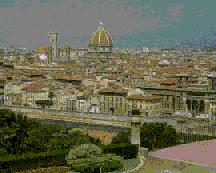 Considered
a single language with numerous dialects, Italian, like the other Romance
languages, is the direct offspring of the Latin
spoken by the Romans and imposed by them on the peoples under their dominion.
Of all the major Romance languages, Italian retains the closest resemblance
to Latin. The struggle between the written but dead language and the various
forms of the living speech, most of which were derived from Vulgar Latin,
was nowhere so intense or so protracted as in Italy.
Considered
a single language with numerous dialects, Italian, like the other Romance
languages, is the direct offspring of the Latin
spoken by the Romans and imposed by them on the peoples under their dominion.
Of all the major Romance languages, Italian retains the closest resemblance
to Latin. The struggle between the written but dead language and the various
forms of the living speech, most of which were derived from Vulgar Latin,
was nowhere so intense or so protracted as in Italy.
During the long period of the evolution of Italian, many dialects sprang up. In the north and northwest the Gallo-Italian dialects predominate; they are Piedmontese, Lombard, Ligurian, and Emilian or Bolognese, all of which display a close affinity to French in their pronunciation and truncated terminations. The Venetian dialect is spoken in the Italian Tirol and parts of what used to be Dalmatia and Istria, in addition to the Venetian area itself. South of these districts the centrosouthern Italian dialects are found; these are Tuscan, Corsican, north Sardinian, Roman (with which are included the closely related dialects of Umbria and The Marches), Campanian (with which are included Abruzzese and Apulian), Sicilian, and Calabrian. South and central Sardinian dialects are so distinct from this entire group of dialects that they constitute a separate branch of the Romance languages, while an Italian dialect of the Eastern Alps, Friulian, which is spoken in northeastern Venetia, is considered by most linguists to be a Rhaeto-Romance language.
The multiplicity of these dialects and their individual claims upon their native speakers as pure Italian speech presented a peculiar difficulty in the evolution of an accepted form of Italian that would reflect the cultural unity of the entire peninsula. Even the earliest popular Italian documents, produced in the 10th century, are dialectal in language, and during the following three centuries Italian writers wrote in their native dialects, producing a number of competing regional schools of literature. During the 14th century the Tuscan dialect began to predominate, because of the central position of Tuscany in Italy, and because of the aggressive commerce of its most important city, Florence. Moreover, of all the Italian dialects, Tuscan departs least in morphology and phonology from classical Latin, and it therefore harmonizes best with the Italian traditions of Latin culture. Finally, Florentine culture produced the three literary artists who best summarized Italian thought and feeling of the late Middle Ages and early Renaissance: Dante, Petrarch, and Boccaccio.
Grammarians during the 15th and the 16th centuries attempted to confer
upon the pronunciation, syntax, and vocabulary of 14th-century Tuscan the
status of a central and classical Italian speech. Eventually this classicism,
which might have made Italian another dead language, was widened to include
the organic changes inevitable in a living tongue. In the dictionaries
and publications of the Accademia della Crusca, founded in 1583, which
have been accepted by Italians as authoritative in Italian linguistic matters,
compromises between classical purism and living Tuscan usage have been
successfully effected.
In modern Italian the Latin qualities of the Florentine dialect are
preserved, but the vocabulary of Latin has been made to meet the changing
conditions of Italian life. The simplicity of the phonetic changes from
Latin, along with an almost perfectly phonetic orthography, makes learning
Italian easy for a person who knows Latin or any of its modern Romance
forms.